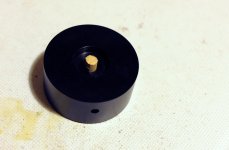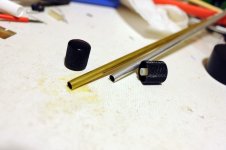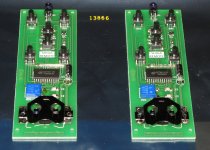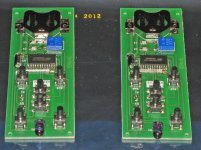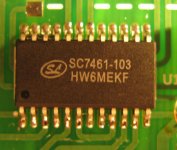That's right ,strange dynamics are there and are killing the music.
Congratulations ,spider web is genius idea and I must try it.Few months ago I found information that spider thread is much stronger than steel and your experiment confirm that fact as it can survive rotating forces ,beside it is sticky and hold the disc in place.
Thanks for suggestions.
I understand the reason you don't share your findings about materials ,exactly as I don't want to share my machinery solutions ,developed for cotton application on my cables since they manage my bills too.Everything in design is transparent but useless for plagiarism except the outer design but that is only a tinny part of cable as complete device and engineering details are secret.You can hardly see them in my avatar.Cotton and wood on signal transfer part and poly material as chassis construction because there are no wires as in widely used hoses.
Congratulations ,spider web is genius idea and I must try it.Few months ago I found information that spider thread is much stronger than steel and your experiment confirm that fact as it can survive rotating forces ,beside it is sticky and hold the disc in place.
Thanks for suggestions.
I understand the reason you don't share your findings about materials ,exactly as I don't want to share my machinery solutions ,developed for cotton application on my cables since they manage my bills too.Everything in design is transparent but useless for plagiarism except the outer design but that is only a tinny part of cable as complete device and engineering details are secret.You can hardly see them in my avatar.Cotton and wood on signal transfer part and poly material as chassis construction because there are no wires as in widely used hoses.
Last edited:
Guys I was wondering. Does the JVC mecha+pcb also have issues with CD-R reproduction?
Not at all, in fact a "classic" Shigaclone is one of the most reliable players for CD-R (I say "classic" because heavily modded Shigas tend to develop issues). I have not had many problems with CDs burned at high speeds either - slow speeds are a little better, but it has not made a massive difference in my experience.
On the other hand, using a Yamaha F1 CD recorder for burning in "Advanced Audio Master Quality Recording" mode does yield a substantially more reliable CD-R, as well as audibly improves the sound (it actually comes pretty close to a pressed CD in a listening test).
Also, I noticed Shigaclones don't like Verbatim's AZO family very much (including Verbatim's "vinyl CD") - skips are much more common on those.
PCB parameters
Tibi, do you have the trace height, thickness, and length on both sides of C59, the PCB substrate height and dielectric Er and the pad and hole sizes for C59 and the external clock location? I'd like to try my hand at calculating the microstrip impedance of the circuit and how that might play into the selction of optimal cap size for the Tent.
Tibi, do you have the trace height, thickness, and length on both sides of C59, the PCB substrate height and dielectric Er and the pad and hole sizes for C59 and the external clock location? I'd like to try my hand at calculating the microstrip impedance of the circuit and how that might play into the selction of optimal cap size for the Tent.
Not at all, in fact a "classic" Shigaclone is one of the most reliable players for CD-R (I say "classic" because heavily modded Shigas tend to develop issues). I have not had many problems with CDs burned at high speeds either - slow speeds are a little better, but it has not made a massive difference in my experience.
On the other hand, using a Yamaha F1 CD recorder for burning in "Advanced Audio Master Quality Recording" mode does yield a substantially more reliable CD-R, as well as audibly improves the sound (it actually comes pretty close to a pressed CD in a listening test).
Also, I noticed Shigaclones don't like Verbatim's AZO family very much (including Verbatim's "vinyl CD") - skips are much more common on those.
Hi uncle_leon,
Any recommendation on new CD-R writter/DVD writter that's sata and capable of records in Advanced Audio Master Quality Recording mode? Those Yamaha or Plexter are PATA drives and very scattered, I have a plexter premium II but it is in PATA, none of my PCs have PATA interface anymore and the PATA to USB doesn't work on Plexter nether.
Hi uncle_leon,
Any recommendation on new CD-R writter/DVD writter that's sata and capable of records in Advanced Audio Master Quality Recording mode? Those Yamaha or Plexter are PATA drives and very scattered, I have a plexter premium II but it is in PATA, none of my PCs have PATA interface anymore and the PATA to USB doesn't work on Plexter nether.
The only burners capable of recording in AMQR were made by Yamaha, and Yamaha has long gone out of the PC burners market. Their last (and the best) recorder was the F1 model, which also had the unique (and very cool) feature called "DiscT@2" - it allowed text and graphics to be "tattooed" onto the unused portion of the burn surface of a CD (unlike lightscribe which works on the label side). This is how it came out on a demo CD I burned for my sister a while back:
An externally hosted image should be here but it was not working when we last tested it.
An externally hosted image should be here but it was not working when we last tested it.
Yamaha did make an external USB version which works fine with new PCs (and has the added advantage of using an external power supply), the model name is CRW-F1UX. It still occasionally pops up on eBay, so keep an eye out for it - I suggest doing a search on eBay, then saving it to your "saved searches" and setting email notifications for it, so you will know right away if one comes up.
Keep in mind that the only software that can do AMQR is Nero, and new Nero did not work properly for me when set to AMQR (it just wasted CDs). I had to install Windows XP on a second drive and install an ancient Nero 5 that came with the burner in order to get everything to work properly.
For a couple of days now I am playing CDs using the Sanyo mecha. Its quality is quite higher than the cheaper one. The spindle is perfectly centered and the sled comes pre-lubricated, while the plastic shielding adds to the overall vibration control.
+lPBRYCv6imNQ~~60_3.JPG)
The increase in clarity is quite substantial in comparison to the cheaper one. The only issue is that it seems that the controller is driving the sled motor too hard and most of the time the sled is banging itself on the limiting switch while going to its home position. Oh and there is a very distinct metal sound probably from the metal spindle...
BTW I decided to make my own puck...
The results...
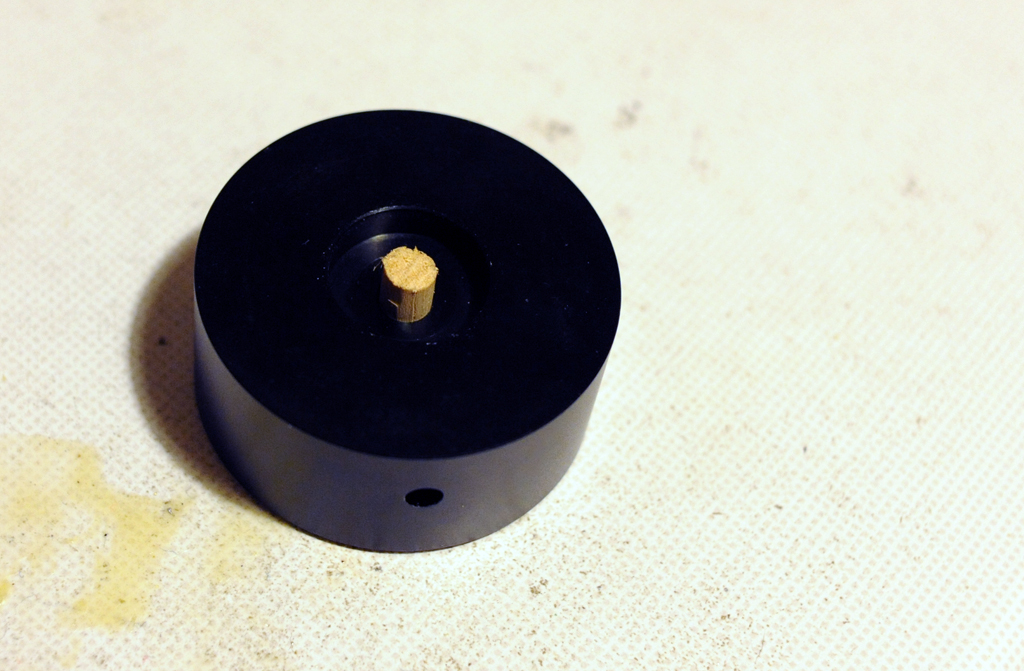
Absolutely perfect centering... while the disc is spinning it is like the puck is not even moving... there is absolutely no wobbling and the mechanical sound is down to almost zero, although I am still getting some of the metal sound from the spindle on some sled-positions/speeds.
For anyone that has not guessed how the puck was created, it is basically an aluminum volume knob. I tried two types, a big one I had for my preamp, and a few smaller ones that I had for my electric bass guitar.
Their hole is (very conveniently) 6mm, while the cavity on their back side fits very nicely to the spindle, which means that I only had to find a suitable axle for it.
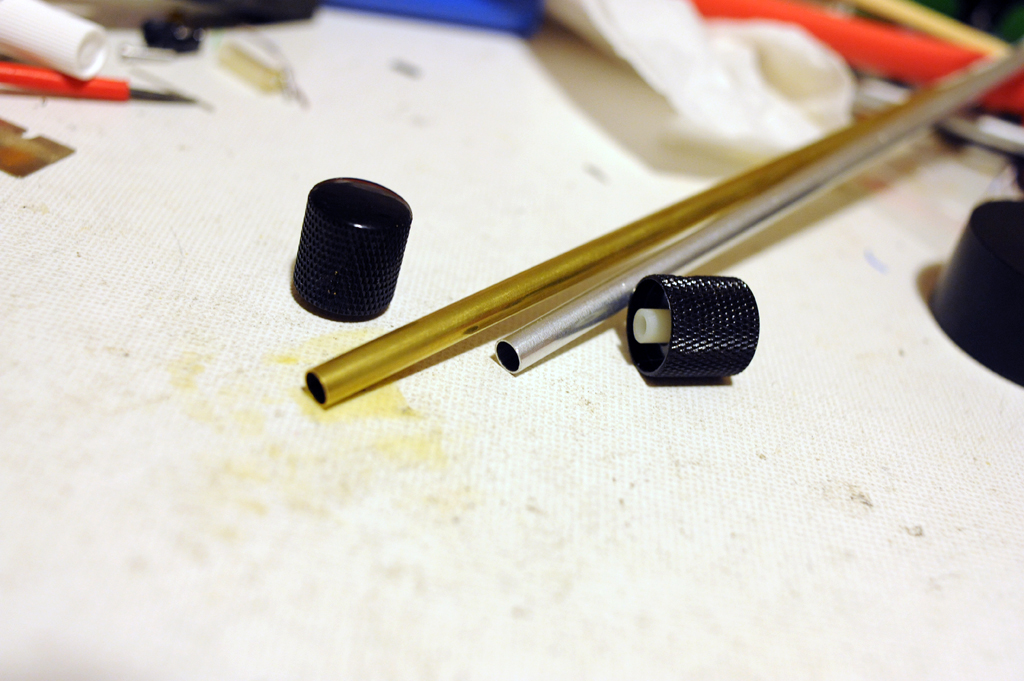
Going through my stuff, I very easily found a few possibilities...
Possible candidates were some plastic pcb standoffs, some brass and aluminum piping and finally some 6mm wooden dowels all coming from my model building days.
All I had to do was cut them to the right length so that the knob is held in place on the spindle while resting on the cd, and then just stick it to the hole.
The metal piping was rattling a bit and the plastic standoffs were not that snug, so the winner was the wooden dowel...
Its fitting is quite snug even without the screws, but I chose to keep them in to help the balance of the puck.
To be honest the big puck is a bit on the heavy side, but it is probably helping the spindle with some additional mass/inertia. The smaller ones also did nicely, but the disc was slipping a bit during starting and stopping, and they did nothing to reduce the metal sound from the spindle.
The result of the two upgrades was phenomenal. The biggest change is audible on the speed and the attack power of bass. I feel like I have bought a new amp... or speakers..
Absolutely phenomenal change...
The increase in clarity is quite substantial in comparison to the cheaper one. The only issue is that it seems that the controller is driving the sled motor too hard and most of the time the sled is banging itself on the limiting switch while going to its home position. Oh and there is a very distinct metal sound probably from the metal spindle...
BTW I decided to make my own puck...
The results...
Absolutely perfect centering... while the disc is spinning it is like the puck is not even moving... there is absolutely no wobbling and the mechanical sound is down to almost zero, although I am still getting some of the metal sound from the spindle on some sled-positions/speeds.
For anyone that has not guessed how the puck was created, it is basically an aluminum volume knob. I tried two types, a big one I had for my preamp, and a few smaller ones that I had for my electric bass guitar.
Their hole is (very conveniently) 6mm, while the cavity on their back side fits very nicely to the spindle, which means that I only had to find a suitable axle for it.
Going through my stuff, I very easily found a few possibilities...
Possible candidates were some plastic pcb standoffs, some brass and aluminum piping and finally some 6mm wooden dowels all coming from my model building days.
All I had to do was cut them to the right length so that the knob is held in place on the spindle while resting on the cd, and then just stick it to the hole.
The metal piping was rattling a bit and the plastic standoffs were not that snug, so the winner was the wooden dowel...
Its fitting is quite snug even without the screws, but I chose to keep them in to help the balance of the puck.
To be honest the big puck is a bit on the heavy side, but it is probably helping the spindle with some additional mass/inertia. The smaller ones also did nicely, but the disc was slipping a bit during starting and stopping, and they did nothing to reduce the metal sound from the spindle.
The result of the two upgrades was phenomenal. The biggest change is audible on the speed and the attack power of bass. I feel like I have bought a new amp... or speakers..
Absolutely phenomenal change...
Attachments
Remotes not working
Hi Tibi. Thanks to those chips I got today I was able to finish the remotes, but neither one seems to be working. I'm attaching pics so if there's anything obvious you might be able to point it out. I'm also attaching a pic showing the soldering job on one of the two chips. I thought it came out okay and it looked good under the magnifier. The other ones looks the same.
In the case of both remotes, pressing any of the buttons does nothing. I checked some of the continuity points, including the 3V to the LED anode. What are some of the critical things I should check?
Hi Tibi. Thanks to those chips I got today I was able to finish the remotes, but neither one seems to be working. I'm attaching pics so if there's anything obvious you might be able to point it out. I'm also attaching a pic showing the soldering job on one of the two chips. I thought it came out okay and it looked good under the magnifier. The other ones looks the same.
In the case of both remotes, pressing any of the buttons does nothing. I checked some of the continuity points, including the 3V to the LED anode. What are some of the critical things I should check?
Attachments
Tibi could you also please explain a bit how the CDRW detection works?
Does 78601-pin53 pull 9242-pin38 high when it detects a CDRW?
Any idea how this detection works and how can we verify that it actually works and applies the extra gain on the eye output?
I do not have a detailed idea on how CD-RW detection is working. I can only speculate that this is based on High Frequency signal level. This should be in direct relation with reflection degree witch is for CD-RW 10-25%, CD-R 40-70% while a pressed original CD have 70-90%.
The rest is done as you mentioned from datasheet:
78601-pin53 pull 9242-pin38 high and increase 9242 HF gain.
Regards,
Tibi
Hi Tibi. Thanks to those chips I got today I was able to finish the remotes, but neither one seems to be working. I'm attaching pics so if there's anything obvious you might be able to point it out. I'm also attaching a pic showing the soldering job on one of the two chips. I thought it came out okay and it looked good under the magnifier. The other ones looks the same.
In the case of both remotes, pressing any of the buttons does nothing. I checked some of the continuity points, including the 3V to the LED anode. What are some of the critical things I should check?
You need to rotate Q1 as per this picture.
http://vicol-audio.ro/img/shiga/remote.jpg
Regards,
Tibi
Hi Tibi,
Actually I wanted to ask this for while, would you be offering any case for the remote?
Thanks
We have designed several ones, wood and Al, but at the end production of these must be in high quantity (>100) and even such the price is over 20euro.
Regards,
Tibi
I am currently working on a wooden one that should be really easy to replicate.
Tibi I am ordering a good quality silver mica for C11. You reckon it could improve CDR reading ability since it is affecting the gain of the eye signal?
C11 is providing a very good decoupling at HF for reference Vr=2.5V.
Vr is used also to bias PIN diodes. Lowering noise will therefore improve reading capability.
C11 have nothing to do with "gain of eye signal".
Regards,
Tibi
Ah yes. I checked the datasheet again. I did not remember correctly the part about the time constant cap on PH1 pin. For some reason I remembered it controlling gain.
Oh and we got it the other way around. The DSP pulls pin 38 low to increase the gain for CDRWs. You think we can try to short the pin to Gnd level and see what happens?
Today I will try to check the output of the chip with the scope.
Oh and we got it the other way around. The DSP pulls pin 38 low to increase the gain for CDRWs. You think we can try to short the pin to Gnd level and see what happens?
Today I will try to check the output of the chip with the scope.
Ah yes. I checked the datasheet again. I did not remember correctly the part about the time constant cap on PH1 pin. For some reason I remembered it controlling gain.
Oh and we got it the other way around. The DSP pulls pin 38 low to increase the gain for CDRWs. You think we can try to short the pin to Gnd level and see what happens?
Today I will try to check the output of the chip with the scope.
Do not short directly to gnd. Use a 4K7-10K resistor.
Regards,
Tibi
- Home
- Source & Line
- Digital Source
- Finally, an affordable CD Transport: the Shigaclone story
